Input interpretation

FeO iron(II) oxide + O_3 ozone ⟶ Fe_2O_3 iron(III) oxide
Balanced equation
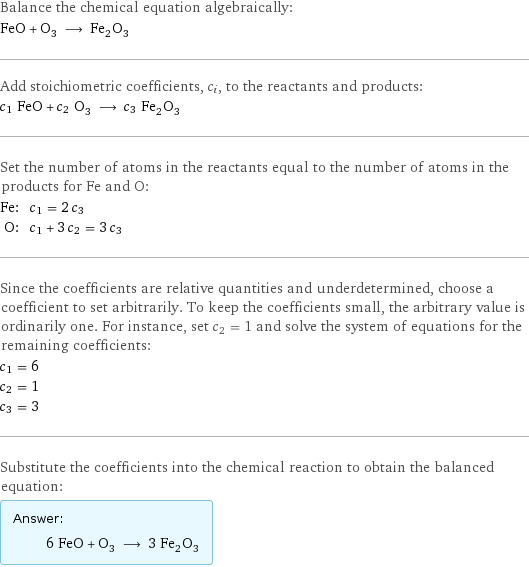
Balance the chemical equation algebraically: FeO + O_3 ⟶ Fe_2O_3 Add stoichiometric coefficients, c_i, to the reactants and products: c_1 FeO + c_2 O_3 ⟶ c_3 Fe_2O_3 Set the number of atoms in the reactants equal to the number of atoms in the products for Fe and O: Fe: | c_1 = 2 c_3 O: | c_1 + 3 c_2 = 3 c_3 Since the coefficients are relative quantities and underdetermined, choose a coefficient to set arbitrarily. To keep the coefficients small, the arbitrary value is ordinarily one. For instance, set c_2 = 1 and solve the system of equations for the remaining coefficients: c_1 = 6 c_2 = 1 c_3 = 3 Substitute the coefficients into the chemical reaction to obtain the balanced equation: Answer: | | 6 FeO + O_3 ⟶ 3 Fe_2O_3
Structures

+ ⟶
Names

iron(II) oxide + ozone ⟶ iron(III) oxide
Reaction thermodynamics
Enthalpy
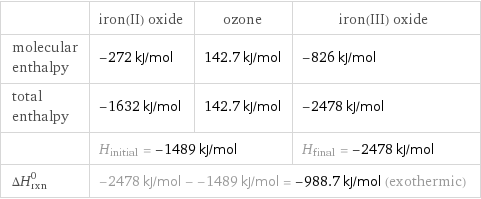
| iron(II) oxide | ozone | iron(III) oxide molecular enthalpy | -272 kJ/mol | 142.7 kJ/mol | -826 kJ/mol total enthalpy | -1632 kJ/mol | 142.7 kJ/mol | -2478 kJ/mol | H_initial = -1489 kJ/mol | | H_final = -2478 kJ/mol ΔH_rxn^0 | -2478 kJ/mol - -1489 kJ/mol = -988.7 kJ/mol (exothermic) | |
Gibbs free energy
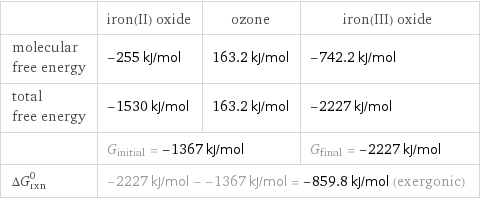
| iron(II) oxide | ozone | iron(III) oxide molecular free energy | -255 kJ/mol | 163.2 kJ/mol | -742.2 kJ/mol total free energy | -1530 kJ/mol | 163.2 kJ/mol | -2227 kJ/mol | G_initial = -1367 kJ/mol | | G_final = -2227 kJ/mol ΔG_rxn^0 | -2227 kJ/mol - -1367 kJ/mol = -859.8 kJ/mol (exergonic) | |
Entropy
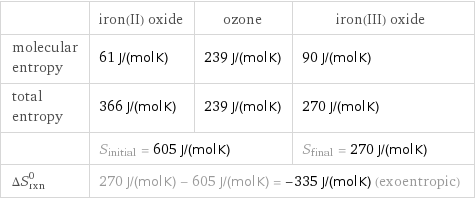
| iron(II) oxide | ozone | iron(III) oxide molecular entropy | 61 J/(mol K) | 239 J/(mol K) | 90 J/(mol K) total entropy | 366 J/(mol K) | 239 J/(mol K) | 270 J/(mol K) | S_initial = 605 J/(mol K) | | S_final = 270 J/(mol K) ΔS_rxn^0 | 270 J/(mol K) - 605 J/(mol K) = -335 J/(mol K) (exoentropic) | |
Equilibrium constant
![Construct the equilibrium constant, K, expression for: FeO + O_3 ⟶ Fe_2O_3 Plan: • Balance the chemical equation. • Determine the stoichiometric numbers. • Assemble the activity expression for each chemical species. • Use the activity expressions to build the equilibrium constant expression. Write the balanced chemical equation: 6 FeO + O_3 ⟶ 3 Fe_2O_3 Assign stoichiometric numbers, ν_i, using the stoichiometric coefficients, c_i, from the balanced chemical equation in the following manner: ν_i = -c_i for reactants and ν_i = c_i for products: chemical species | c_i | ν_i FeO | 6 | -6 O_3 | 1 | -1 Fe_2O_3 | 3 | 3 Assemble the activity expressions accounting for the state of matter and ν_i: chemical species | c_i | ν_i | activity expression FeO | 6 | -6 | ([FeO])^(-6) O_3 | 1 | -1 | ([O3])^(-1) Fe_2O_3 | 3 | 3 | ([Fe2O3])^3 The equilibrium constant symbol in the concentration basis is: K_c Mulitply the activity expressions to arrive at the K_c expression: Answer: | | K_c = ([FeO])^(-6) ([O3])^(-1) ([Fe2O3])^3 = ([Fe2O3])^3/(([FeO])^6 [O3])](../image_source/bca8c6b4a6d985f08e62fdbf28693566.png)
Construct the equilibrium constant, K, expression for: FeO + O_3 ⟶ Fe_2O_3 Plan: • Balance the chemical equation. • Determine the stoichiometric numbers. • Assemble the activity expression for each chemical species. • Use the activity expressions to build the equilibrium constant expression. Write the balanced chemical equation: 6 FeO + O_3 ⟶ 3 Fe_2O_3 Assign stoichiometric numbers, ν_i, using the stoichiometric coefficients, c_i, from the balanced chemical equation in the following manner: ν_i = -c_i for reactants and ν_i = c_i for products: chemical species | c_i | ν_i FeO | 6 | -6 O_3 | 1 | -1 Fe_2O_3 | 3 | 3 Assemble the activity expressions accounting for the state of matter and ν_i: chemical species | c_i | ν_i | activity expression FeO | 6 | -6 | ([FeO])^(-6) O_3 | 1 | -1 | ([O3])^(-1) Fe_2O_3 | 3 | 3 | ([Fe2O3])^3 The equilibrium constant symbol in the concentration basis is: K_c Mulitply the activity expressions to arrive at the K_c expression: Answer: | | K_c = ([FeO])^(-6) ([O3])^(-1) ([Fe2O3])^3 = ([Fe2O3])^3/(([FeO])^6 [O3])
Rate of reaction
![Construct the rate of reaction expression for: FeO + O_3 ⟶ Fe_2O_3 Plan: • Balance the chemical equation. • Determine the stoichiometric numbers. • Assemble the rate term for each chemical species. • Write the rate of reaction expression. Write the balanced chemical equation: 6 FeO + O_3 ⟶ 3 Fe_2O_3 Assign stoichiometric numbers, ν_i, using the stoichiometric coefficients, c_i, from the balanced chemical equation in the following manner: ν_i = -c_i for reactants and ν_i = c_i for products: chemical species | c_i | ν_i FeO | 6 | -6 O_3 | 1 | -1 Fe_2O_3 | 3 | 3 The rate term for each chemical species, B_i, is 1/ν_i(Δ[B_i])/(Δt) where [B_i] is the amount concentration and t is time: chemical species | c_i | ν_i | rate term FeO | 6 | -6 | -1/6 (Δ[FeO])/(Δt) O_3 | 1 | -1 | -(Δ[O3])/(Δt) Fe_2O_3 | 3 | 3 | 1/3 (Δ[Fe2O3])/(Δt) (for infinitesimal rate of change, replace Δ with d) Set the rate terms equal to each other to arrive at the rate expression: Answer: | | rate = -1/6 (Δ[FeO])/(Δt) = -(Δ[O3])/(Δt) = 1/3 (Δ[Fe2O3])/(Δt) (assuming constant volume and no accumulation of intermediates or side products)](../image_source/6c23651b36784803b6542bcc5622d9e5.png)
Construct the rate of reaction expression for: FeO + O_3 ⟶ Fe_2O_3 Plan: • Balance the chemical equation. • Determine the stoichiometric numbers. • Assemble the rate term for each chemical species. • Write the rate of reaction expression. Write the balanced chemical equation: 6 FeO + O_3 ⟶ 3 Fe_2O_3 Assign stoichiometric numbers, ν_i, using the stoichiometric coefficients, c_i, from the balanced chemical equation in the following manner: ν_i = -c_i for reactants and ν_i = c_i for products: chemical species | c_i | ν_i FeO | 6 | -6 O_3 | 1 | -1 Fe_2O_3 | 3 | 3 The rate term for each chemical species, B_i, is 1/ν_i(Δ[B_i])/(Δt) where [B_i] is the amount concentration and t is time: chemical species | c_i | ν_i | rate term FeO | 6 | -6 | -1/6 (Δ[FeO])/(Δt) O_3 | 1 | -1 | -(Δ[O3])/(Δt) Fe_2O_3 | 3 | 3 | 1/3 (Δ[Fe2O3])/(Δt) (for infinitesimal rate of change, replace Δ with d) Set the rate terms equal to each other to arrive at the rate expression: Answer: | | rate = -1/6 (Δ[FeO])/(Δt) = -(Δ[O3])/(Δt) = 1/3 (Δ[Fe2O3])/(Δt) (assuming constant volume and no accumulation of intermediates or side products)
Chemical names and formulas
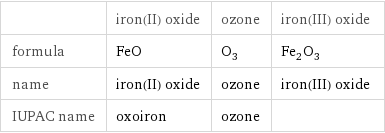
| iron(II) oxide | ozone | iron(III) oxide formula | FeO | O_3 | Fe_2O_3 name | iron(II) oxide | ozone | iron(III) oxide IUPAC name | oxoiron | ozone |
Substance properties
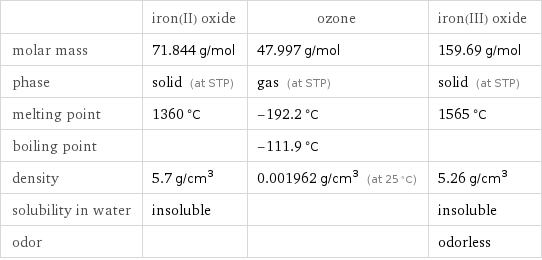
| iron(II) oxide | ozone | iron(III) oxide molar mass | 71.844 g/mol | 47.997 g/mol | 159.69 g/mol phase | solid (at STP) | gas (at STP) | solid (at STP) melting point | 1360 °C | -192.2 °C | 1565 °C boiling point | | -111.9 °C | density | 5.7 g/cm^3 | 0.001962 g/cm^3 (at 25 °C) | 5.26 g/cm^3 solubility in water | insoluble | | insoluble odor | | | odorless
Units
